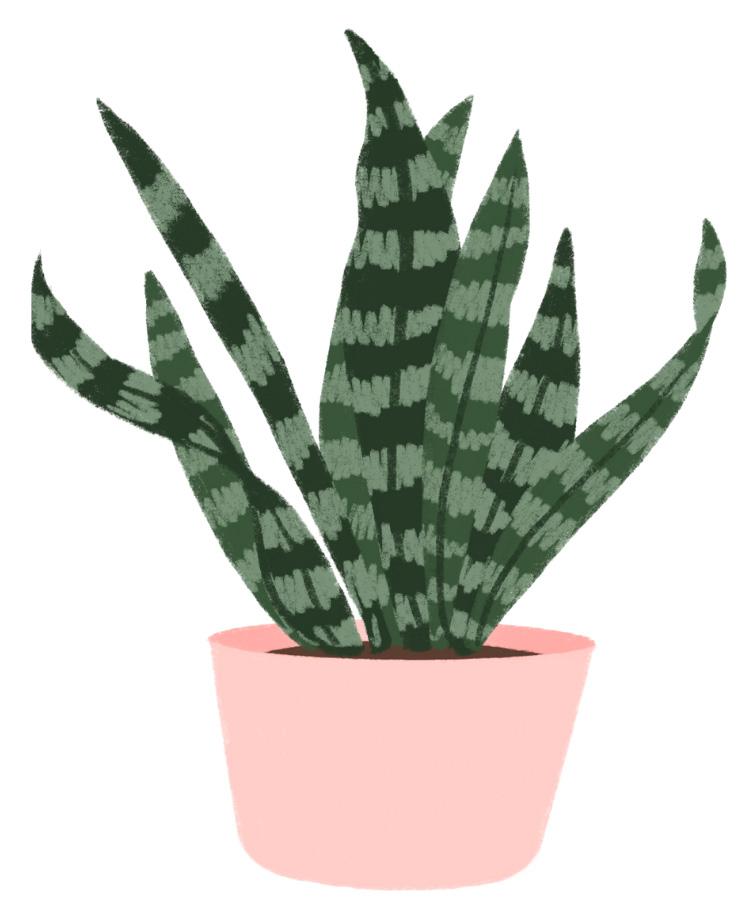
3 minute read
A guide to caring for plants in your dorm
Dorms can be dull, boring and gray – especially when you have little to no decor. Making your dorm feel more warm and inviting can be as simple as adding some plants, but caring for those plants is a different story altogether. We’re here to help.
By Logan Linder
Advertisement
a nice way to brighten up the room and allow for a breath of fresh air in a stuffy building.
Taking care of plants, on the other hand, isn’t as easy. This short guide should help point you in the right direction if wanting to add new, live friends to your room.
When deciding to add plants to your dorm, it’s important to choose ones you have the time and resources to take care of. If you’re trying to grow herbs or vegetables, they take more effort and care, whereas simple air plants or succulents require attention only every so often.
Other low-maintenance plant options include bird’s nest fern and parlor palms. If you’re wanting to grow herbs or flowers, more care is required, so be prepared to dedicate time to them. Before purchasing any plants, do your research to know what you’re getting yourself into. and water them no more than every two weeks in warmer months. In the winter, months can pass by before needing to water them again.
Dwarf umbrella tree (Schefflera arboricola)
Low light plants
Snake plant (Dracaena trifasciata)
This plant is a common indoor, low light plant that’s easy to take care of. When taking care of snake plants, it’s best to place them in indirect sunlight
If you’re susceptible to forgetting to water your plants, the dwarf umbrella tree is a great option. It’s able to survive missed days of watering, but it still needs to be watered to prevent the leaves from wilting. Water when the soil begins to wilt and keep the soil well-drained. For light, these plants prefer indirect lighting and are able to survive in dark corners, the width will just be hindered.
Christmas cactus (Schlumbergera bridgesii)
With its green foliage and colored blooms, the Christmas cactus can survive in multiple kinds of sunlight.

The cactus can adapt to lowlight conditions and blooms the most in direct sunlight, however, the leaves can easily burn if in too much sunlight. Frequent and thorough watering is required, but allow the soil to dry partially before re-watering.
take three to five years before the plant actually flowers, you’ll have a nice coffee scent in your dorm to tide you over.
Jasmine (Jasminum)

If you’re wanting a plant with more than just leaves and a slight scent, I’d recommended jasmine. The lighting for these is tricky, as they need to be in a well-lit environment, but also can only tolerate up to four hours of direct sunlight. When watering, keep the soil moist and well-drained.
maintenance than regular succulents. They can grow up to at least three feet over the years and have a tendency to become top heavy. Jade plants need bright, indirect sunlight and it’s best to water them when the soil is dry to the touch, but water them a little more frequently in hotter months, keeping the soil moist.
Basil (Ocimum basilicum)
Medium light plants
African violet (Saintpaulia)
African violets are tricker to take care of, but with proper care they can bloom and lighten up your bland dorms with their purple flowers.
Bright to medium intensity light is best, and it’s recommended that you rotate the pot once a week so the light is evenly distributed over all of the leaves. As for watering the violets, it’s best to use lukewarm water and keep the soil moist, but never fully dry.

Coffee plant (Coffea)
For coffee lovers, try investing in growing your own coffee plant. These require the soil to constantly be moist and surrounded by high humidity. It’s best to place these plants near a window, but not directly by one. While it may

High light plants
Hibiscus (Hibiscus)
For a tropical touch to your room, hibiscus’ are a great option, especially during the summer. Giving these plants as much direct light as possible during the winter is ideal, placing them outside in the summer and slowly acclimating them to more light. These can be watered freely during the summer.
Jade (Crassula arborescens)
While this plant is a kind of succulent, they require more
For a nice aroma, and a way to add some freshness into your dining hall meals, begin growing a basil plant. Keep the soil moist and well-drained and water on a regular basis. Basil plants need around six hours of sunlight each day.
And if all of your plants die… We’ve all been there. If you’ve done everything you can possibly think of and your plants still manage to die, your room or dorm may simply not be habitable for plant life. If you want to brighten it up, maybe look into fake plants.











